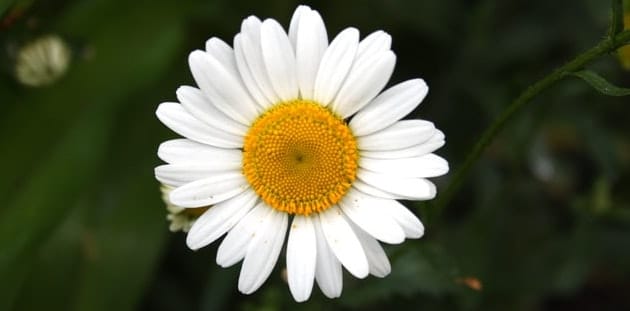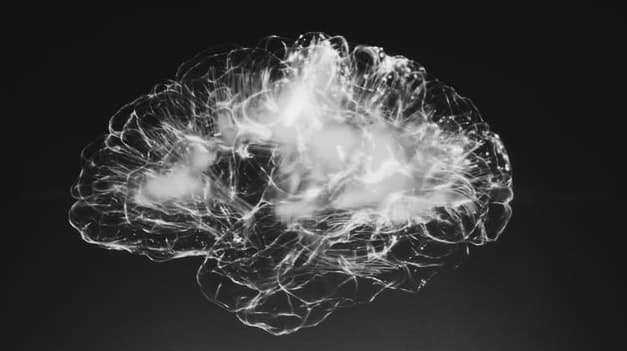Chamomile is a popular herb of the Asteracae family that is commonly used in herbal medicine to treat things like: stomach aches; irritable bowel syndrome; constipation; inflammation; and anxiety. (Read: Chamomile for anxiety)
Although many people find chamomile to be safe, tolerable, and effective for various health ailments and psychological stress – some wonder whether suddenly stopping it after regular use could trigger withdrawal symptoms.
Is there any scientific evidence of chamomile withdrawal?
At this time there’s zero formal scientific evidence to substantiate the idea that chamomile withdrawal exists.

However, lack of scientific evidence to support the idea of chamomile withdrawal should not be assumed to mean that chamomile withdrawal doesn’t exist. (Absence of evidence doesn’t imply evidence of absence.)
For example, a study by Mao et al. (2016) examined the effect of chamomile extract (500 mg, t.i.d.) for a long-term (up to 38 weeks) – but researchers didn’t examine whether a withdrawal occurred upon cessation. (R)
Why might there be a chamomile withdrawal?
Biological plausibility. Though not every drug, medication, and supplement has withdrawal symptoms – many do as a result of physiological adaptation.
Chronic, long-term administration of chamomile causes aspects of one’s physiology and neurochemistry to adapt to its regular presence/effect.
Cessation of chamomile following chronic, long-term administration will force one’s physiology and neurochemistry to shift back to homeostasis (functioning without chamomile’s influence).
The physiological recalibration from: (A) chamomile-adapted physiology – back to (B) physiological homeostasis – could cause withdrawal symptoms to emerge.
Physiological underpinnings of chamomile withdrawal… (Hypothesized)
The exact mechanisms by which chamomile’s bioactive compounds modulate aspects of human physiology/neurochemistry remains unclear.

There are plenty of non-human (animal) and human cell line studies involving chamomile and its bioactive compounds (e.g. apigenin).
If chamomile modulates physiology to a significant extent (such as with high-dose administration) – the following neurochemical targets might contribute to withdrawal.
- GABA neurotransmission: Numerous studies support the idea that chamomile and its chief bioactive constituent, apigenin, modulate the neurotransmission of GABA and the activation of GABA receptors. That said, the specifics of GABAergic modulation remain unclear (as some studies have contradictory findings regarding action at the GABA-A receptor).
- Monoamines & MAO enzymes: Chamomile is thought to function as a monoamine oxidase inhibitor (MAOI) for both MAO-A and MAO-B enzymes. It has also been shown to influence the neurotransmission of monoamines (serotonin, dopamine, norepinephrine).
- HPA axis: Chamomile is thought to interact with the HPA axis such that stress hormone (e.g. cortisol & ATCH) secretion decreases.
- Inflammation: Chamomile has been observed to reduce inflammation as a selective COX-2 inhibitor.
Dysregulation of the above physiological targets (and potentially others that are lesser known) following the cessation of chamomile – may account for chamomile withdrawal symptoms.
The greater the degree of physiological dysregulation during withdrawal, the more pronounced withdrawal symptoms are likely to be.
Chamomile withdrawal symptoms…
Included below are hypothetical withdrawal symptoms that may occur following discontinuation of chamomile – based on its hypothesized mechanisms of action.

Keep in mind that there’s no evidence that chamomile withdrawal actually exists, however, it is biologically plausible that chamomile withdrawal might occur based on its multi-faceted pharmacological actions within the brain/CNS.
Anxiety: The most significant withdrawal symptom from chamomile for most users will be anxiety. The anxiety may be characterized by rapid thoughts, increased muscle tension, fear of certain situations, and an inability to relax.
Insomnia: Chamomile often helps reduce anxiety while simultaneously enhancing sleep – particularly when administered at night. Discontinuation of chamomile can cause primary insomnia (difficulty falling asleep) and/or maintenance insomnia (difficulty staying asleep).
Sleep disturbances: Due to changes in neurochemistry following long-term chronic chamomile use, some may notice a variety of sleep disturbances surfacing after stopping chamomile. Sleep disturbances may include: night sweats, weird/bizarre/vivid dreams, nightmares, abnormal sleep cycles, rolling around more during the night, etc.
Agitation: Some may experience agitation after stopping chamomile. This is characterized by a state of nervous excitement wherein a person may feel “stirred up,” tense, confused, and irritable – and this may cause a person to have the urge to move more frequently (e.g. pace back and forth).
Restlessness: Feeling restless or unable to rest/relax as a result of anxiety might occur when stopping chamomile.
Depression & mood changes: Because chamomile can influence both mood and anxiety – some individuals report depression and/or mood changes after stopping.
Brain fog & cognitive impairment: Chamomile isn’t inherently known as a cognitive enhancer, however, a resurgence of anxiety and/or sleep disturbances after stopping may cause brain fog and cognitive deficits.
Gastrointestinal reactions: Some individuals may notice changes in gastrointestinal function after stopping chamomile (e.g. upset stomach, diarrhea, constipation, acid reflux, etc.).
Note: There may be a variety of other symptoms that surface during chamomile withdrawal. Do not assume the above is a comprehensive list of every possible reaction.
Factors that influence chamomile withdrawal (severity & duration)
Included below are factors that might influence chamomile withdrawal (in the event that it occurs).

Chamomile dosage
The dosage of chamomile ingested on a regular basis is likely to determine the severity and/or length of withdrawal.
Because high doses exert a greater shift in physiology away from homeostasis relative to lower doses – high doses will be associated with a harsher withdrawal.
Low dose chamomile won’t shift physiology as far from homeostasis as high dose chamomile – therefore it should take less time for physiology to recalibrate back to homeostasis in withdrawal.
Duration of [frequent] chamomile use
The cumulative duration of regular (i.e. daily or multiple times per day) chamomile use is likely to influence withdrawal severity.
Individuals who use chamomile at least once a day for months/years are more likely to experience withdrawal than those who use chamomile regularly for just one or two weeks.
Why? There may be certain physiological changes that only emerge after regular long-term (e.g. months or years) administration of chamomile – but not after regular short-term use (e.g. several weeks).
Therefore, physiological readjustment back to homeostasis may take more total time after chamomile cessation for long-term users.
It is likely that there’s no additional “physiological adaptation” beyond a certain time point of regular use (e.g. 6 months) – such that using even longer (e.g. 2 years) won’t yield any additional physiological changes to make withdrawal more difficult.
Infrequent use of chamomile such as once or twice a week is very unlikely to cause any sort of “withdrawal.” Why? Because one’s physiology never fully adapts to being under the constant influence of chamomile (it shifts back to homeostasis between doses).
High-frequency (e.g. 3-5 times daily) long-term (e.g. 3+ months) users will be more likely to experience a withdrawal (assuming chamomile withdrawal occurs) than low-frequency/short-term users.
Rate of chamomile discontinuation
If you’re a frequent/chronic long-term chamomile user, rate of chamomile discontinuation may influence the severity of withdrawal symptoms.
Stopping chamomile suddenly (i.e. cold turkey) from a high-dose after using it frequently (e.g. 3-5 times daily) for a long-term (e.g. 1 year) is more likely to cause a harsher withdrawal than gradual dosage reduction over a period of weeks.
Why? Because physiology is strongly adapted to a high-dose of frequent chamomile administration – and the physiological shift required to reach homeostasis is greater than low-dose/less frequent chamomile use, hence an increased likelihood of harsher withdrawal.
Specific chamomile used (species & composition)
The 2 most common species of chamomile include: German chamomile and Roman chamomile.
Although similar, these species have distinct/unique phytochemical compositions – such that the bioactive compounds ingested may differ in percentages as would specific neurochemical modulation and subsequent physiological adaptations.
My guess is there won’t be a significant difference withdrawing from German chamomile vs. Roman chamomile – but there might be subtle differences due to variance in phytochemical composition.
Chamomile format & route of admin
The specific format of chamomile that’s routinely administered (e.g. tea, extract, etc.) may influence the severity of withdrawal in some capacity.
The most common modes of chamomile administration include: drinking chamomile tea and oral chamomile extract supplements.
Less commonly, chamomile is administered sublingually (as an oil) or inhaled as a vapor or smoke (some people smoke chamomile).
Since chamomile formatting and route of administration can affect pharmacokinetics, pharmacodynamics, and overall magnitude of physiological effect – these variables may influence likelihood and/or severity of chamomile withdrawal.
Other factors that may impact chamomile withdrawal…
- Use of other substances: Could make chamomile withdrawal more or less difficult depending on the specific substances. Some anxiolytic agents might cover up a chamomile withdrawal – whereas other anxiogenic substances might exacerbate it.
- Diet & lifestyle: A healthy diet and lifestyle should make withdrawal easier to bear – whereas an unhealthy diet and lifestyle might exacerbate withdrawal symptoms.
- Sleep & circadian rhythm: Adequate sleep and a proper circadian rhythm should make withdrawal easier – whereas insufficient/suboptimal sleep and circadian dysregulation might make it more difficult.
- Stress & mood: Managing stress and mood should make withdrawal easier to manage than unmanaged stress and moods.
- Genetics & epigenetics: Certain genetics and epigenetics might make withdrawal more/less difficult.
- Expectation: Expectation can influence physiology (as evidenced by placebo/nocebo effects). Expecting withdrawal to be easy might make it easier than expecting withdrawal to be difficult.
How long will chamomile withdrawal last?
Unknown. Technically chamomile withdrawal lasts as long as it takes one’s physiology to transition from a chamomile-adapted state back to pre-chamomile homeostasis.
The duration of chamomile withdrawal is thought to be influenced by dosage, duration & frequency of use, and whether a person tapered their dosage down before completely quitting.
Obviously if a person tapers their dosage down, they may experience some mild withdrawal symptoms during the tapering progress as physiology adjusts to slight reductions in chamomile intake.
However, reversion back to homeostasis following the final dose of a taper will be quicker and more manageable than if a person stops “cold turkey” from a high-dose.
For most people, “withdrawal symptoms” that emerge following regular chamomile discontinuation probably won’t last more than 2-4 weeks (in the event that they actually occur).
How to withdraw from chamomile (recommendations)
These recommendations are for individuals who are having a difficult time withdrawing from chamomile (for whatever reasons). Keep in mind that most people will have ZERO difficulty stopping chamomile.

Gradual dosage reduction
Those who used chamomile: (A) frequently (multiple times daily); (B) at a high-dose; and (C) for a long-term – may benefit from gradual dosage reduction of chamomile.
- A conservative dosage reduction involves something like a ~10% dosage reduction per week.
- Individuals who were drinking chamomile tea may want to switch to chamomile extract and measure the exact amount of chamomile extract (with a scale).
Manage medical conditions
If you were using chamomile to treat medical conditions like anxiety, insomnia, sleep disturbances, etc. – it’s important to realize that these conditions and corresponding symptoms might resurface after chamomile discontinuation.
The resurfacing of symptoms associated with medical conditions may be confused by some as being chamomile withdrawal symptoms – when they are actually just a resurfacing of medical condition symptoms.
In some cases, there may be overlap between withdrawal and medical symptoms. Nonetheless, it’s important to effectively manage medical conditions during withdrawal.
Healthy diet & lifestyle
Consuming a nutrient dense, calorically-appropriate diet may help if experiencing withdrawal symptoms.
Overeating/undereating and/or improper nutrition has potential to cause its own set of symptoms that may exacerbate withdrawal symptoms.
A healthy lifestyle should include things like: regular exercise; socializing with friends/family; stress management; circadian rhythm optimization; sleep prioritization; etc.
Consult a medical doctor (if necessary)
If you’re really struggling with chamomile withdrawal, it may be smart to consult a medical doctor to treat the symptoms that are most problematic.
For example, if you’re struggling with anxiety, it may be wise to utilize a prescription anxiolytic and stabilize your anxiety – then gradually reduce the dose over time under medical supervision.
Supplements for Chamomile withdrawal
Some individuals may benefit from taking supplements to take the edge off of chamomile withdrawal.
Note: These are affiliate links – so I’ll earn a small commission if you buy the products with my links. I’d appreciate if you buy through my link (as the cost is equal) – but it’s cool if you don’t.
Also – do NOT take supplements without first verifying safety with a medical doctor/pharmacist.
- Magnesium threonate: This version of magnesium is thought to be most efficient in crossing the blood-brain-barrier and modulating neurochemistry. Most find that magnesium threonate induces relaxation and improves sleep quality.
- Magnesium glycinate: A cheaper version of magnesium bound to glycine that is also effective for reducing anxiety, enhancing sleep, and facilitating a state of calmness.
- Melatonin: A chronobiotic that helps: regulate the circadian rhythm, improve sleep quality, and decrease anxiety.
- Glutathione: This is a reduced form of glutathione that is understood to decrease oxidative stress (reactive oxygen species & reactive nitrosative species) – which could be beneficial if oxidative stress is high.
- Probiotics: Dysbiosis of gut microbiota might occur for some in chamomile withdrawal – as chamomile is thought to improve gut bacteria composition. A probiotic supplement may help correct any gut bacteria abnormalities that emerge.
- Multivitamin: A basic multivitamin will decrease likelihood that withdrawal symptoms are due to nutritional deficiencies.
- Taurine: Can help decrease anxiety/stress for some individuals.
- Omega-3 fatty acids: High-dose omega-3 fatty acids tend to decrease inflammation and may support neurotransmitter production to decrease stress.
- L-Tyrosine: An amino acid precursor necessary for the production of dopamine and norepinephrine.
- L-Theanine: An anxiolytic supplement that may prove useful if dealing with chamomile withdrawal.
- Lithium orotate: A supplemental version of lithium that many find helpful for reducing anxiety and stabilizing mood.
- Electrolytes: Some may find supplementation with electrolytes useful during chamomile discontinuation.
- Alpha Lipoic Acid: Oxidative stress/inflammation reducing agent.
- Glycine: Can help decrease stress and anxiety – and may enhance sleep.
- Vitamin D: If you’re low on vitamin D – it might impact brain chemistry and aspects of health.
- B vitamin complex: Many find that B vitamins induce a state of calmness – such as to counteract any anxiety that occurs in chamomile withdrawal.
Distinguishing chamomile withdrawal from rebound medical condition…
Some individuals may experience a combination of: (A) chamomile withdrawal symptoms and (B) reemergence of symptoms associated with medical conditions that chamomile helped treat (e.g. anxiety, insomnia, depression, etc.).
Others may experience one or the other: (A) primarily chamomile withdrawal symptoms OR (B) returning symptoms associated with medical conditions.
Those who experience rebound symptoms associated with a specific medical condition may mistake these symptoms for some sort of “chamomile withdrawal.”
The only way to discern “withdrawal” symptoms from resurgence of medical symptoms is to think about how the symptoms were prior to chamomile use.
If there are any “new symptoms” or significantly more severe symptoms that emerge after chamomile cessation – there’s a decent chance these are from withdrawal.
That said, this can be difficult – particularly if a person is using various medications and/or supplements or is experiencing significant stress (such as from relationships, finances, work, etc.) – as these may be misattributed to “withdrawal.”
Chamomile withdrawal anecdotes
Are there any anecdotes suggesting that chamomile withdrawal exists? There are a few paraphrased below.
That said, we should keep in mind that anecdotes are not strong evidence to support the idea that chamomile withdrawal exists.
Chamomile is a relatively popular herbal tea and supplement. Assuming even a small percentage of individuals use chamomile regularly and suddenly stop – there would likely be more anecdotes posted online about withdrawal.
Anecdote #1
For the past 5 days my anxiety has been through the roof. Panicky, upset, shaky, worrying, etc.
Then I realized that I stopped chamomile which I had been taking every night for sleep in pill form for the past 2 years.
This anxiety is markedly terrible so this isn’t standard.
Anecdote #2
About 2 years ago I drank too much chamomile and lemon balm tea to help sleep and cope with anxiety. I’ve had protracted withdrawals ever since – it’s going away really slow.
I had very extreme anxiety with the classic PAWS (post-acute withdrawal syndrome) waxing and waning at different intervals throughout the whole healing process.
Nobody believes me and it’s the most gas-lighting and awful experience ever because I get zero emotional support from anyone.
Anecdote #3
Used chamomile tea to get off hydrocodone in 2018. It helped immensely but now am addicted to the chamomile.
I cut my chamomile tea dose in half after opioid discontinuation but then hit a wall of anxiety.
Several failed tapers off of chamomile ensued. Have managed to get from 5 cups to 4 cups over the last 2 months but it’s not been that easy.
The main symptoms are increased anxiety, sleep disruptions, restless arms, and peripheral neuropathy.
My thoughts on chamomile withdrawal…
Although I’ve never used chamomile at a high-frequency (e.g. several times per day) and/or for a long-term (e.g. months) – I have used chamomile nightly for several consecutive weeks.
Upon cessation of chamomile I did NOT notice any withdrawal symptoms… So in my case, even if there was somewhat of a physiological recalibration after stopping, it wasn’t noticeable.
The lack of withdrawal in my case might be attributable to using chamomile only at night and/or only for a few weeks.
If chamomile withdrawal does occur, I suspect that it would be relatively mild/benign compared to more potent pharmaceutical medications (but admittedly I could be incorrect – particularly for dosages beyond 1500 mg per day).
A majority of people I know that use chamomile regularly do NOT experience any significant discontinuation symptoms upon chamomile cessation.
Note: It is more common for chamomile to be used in withdrawal from more potent neurochemical modulators like antidepressants, benzodiazepines, and opioids.
Have you experienced chamomile withdrawal symptoms?
- What was the frequency and duration of your chamomile use? (e.g. 3x daily for 2 years)
- What dosage of chamomile did you take?
- What was your mode of chamomile administration? (e.g. tea, extract, oil, smoking, etc.)
- Did you experience chamomile withdrawal symptoms?
- How confident are you that your symptoms are from chamomile withdrawal? (And not from other confounds like environmental stressors or rebound symptoms of a medical condition?)
- If you experienced chamomile withdrawal – how long did your symptoms last?
Hi and thanks for this article. I am more than certain that I experience withdrawals, even from one serving – like the saying ‘what goes up (stimulants), must come down” the reverse is also true, “what goes down (downers), must come up”. The painful admission is that I still haven’t learned my lesson. The herbal teas I make (with a plunger) are in the organic loose leaf form and they can’t get much more pure than that. So even a tspn of dried Chamomile in a two cup plunger is enough for me to experience withdrawal symptoms you have mentioned above: anxiety, intense agitation, restlessness, mood changes and brain fog. On top of these symptoms my senses and nervous system feel very sensitive, especially to sounds.
I woke during last night (around 3am) and lay wide awake for half an hour so decided to make a serving of chamomile (as above and steeped for approx 5mins). Although it did help me fall back to sleep, when I woke I didn’t feel ‘right’ and so I got up and, reusing the flowers that were already in my plunger, steeped a second serving. That was a huge mistake. I felt dopey, fell asleep on the sofa and when I came too felt worse than I did when I got out of bed. And I know it is the chamomile because the withdrawal symptoms remind me of benzodiazepines withdrawals (for the record, I no longer take benzos). The one striking symptom that increases my confidence that it is the chamomile at work is that I then endeavoured to go outside and the experience I have is one like I am in a bubble, that the environment around me is kind of ‘dreamy’ as though I am doped up (again, similar to benzos).
I admit I am probably a rare case due to my CYP metabolism issues (makes it hard to regulate) but my experience is very real and it makes life difficult when it causes such a roller-coaster ride. I hope my comments helps others. Blessings.